第9回講演会
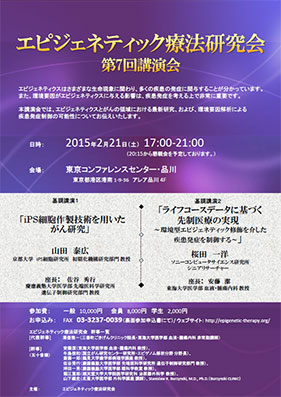
- 日程
- 2017年2月25日(土)
- 会場
- イタリア文化会館ビル 3階 コーチホール
- 来場者数
- 40名
- 講演内容
-
-
基調講演
「大腸がんのゲノム・エピゲノムレベルの進化と多様性の解明」
三森 功士(九州大学病院別府病院 外科 教授)座長:山下 継史(北里大学医学部外科学 専任講師)
-
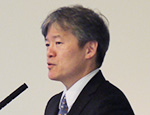
大腸癌はわが国において、罹患率、致死率ともに増加しているが、大腸がんが難治である主要因の一つは腫瘍内不均一性・多様性にあることは論を待たない。大腸癌症例の生命予後改善のためには、癌細胞自身の進化機構決めるゲノムおよびエピゲノムの進化についても俯瞰的かつ経時的に理解することが必要である。われわれは、大腸がんの多領域分割解析による一腫瘍内多様性解析を行い、腫瘍細胞全体に共通して存在するfounderゲノム変異(メインクローン)と多様性を形成するprogresserゲノム変異(サブクローン)について数理統計学的処理により系統樹を描き時空間的ながんゲノムおよびエピゲノム進化様式を明らかにした(PLoS Genet 2016)。興味深いことに、ゲノムレベルではサブクローンにはドライバー変異がなく、マイナーな変異のみで多様性を形成していることを明らかにした。また、エピゲノムレベルではCpG islandの高メチル化を一腫瘍内で普遍的に認め、seaやshoreの低メチル化には偏りがあり、これが多様性を形成していることが明らかとなった。われわれの知見は、既存のがん進化モデル(Big Bang modelなど)と異なった進化形式であった。 また、腫瘍内不均一性を生み出すがんの進化原理ついての理解はほとんどなされていないのが現状であった。そこでその目的を達するために、われわれはがんの分岐進化シミュレーションモデル(branching evolutionary processモデル; BEPモデル)を構築し、スーパーコンピュータ「京」を用いて高並列シミュレーションを行うことにより、大腸がん実験データに観察される様な広汎な腫瘍内不均一性を再現する条件の網羅的探索をおこなった結果、がんの多様性を生じる選択圧についてもお示ししたい。
-
研究発表
「マイクロアレイを用いた包括的遺伝子検索による
癌治療抵抗性遺伝子の同定と比較腫瘍学」
山下 継史(北里大学医学部外科学 専任講師)座長:安藤 潔(東海大学医学部 血液・腫瘍内科 教授)
-

癌抑制遺伝子や癌原遺伝子の発現は癌組織においてダイナミックに変化しており、その異常はgenomicあるいはepigeneticな異常が起因する。われわれは、epigeneticな異常を抑えることで癌が抑制できるかどうか、またその異常がなぜ治療抵抗性に関わるのかに注目して治療標的を同定する研究を展開している。Phenylbutyrate (PB)はヒストンの脱アセチル化(HDAC)拮作用があり、その epigeneticな作用機序を介してほとんどの癌細胞の増殖を強く抑制する。一方、癌細胞によりその抑制程度が異なり、その程度の違いを説明できる分子機序を同定することは治療戦略を考察する上で重要である。乳癌、大腸癌行われた探索的研究によると、乳癌においては Zeb1遺伝子、大腸癌においてはAscl2遺伝子が治療抵抗性に強く関わった。前者は epigeneticに、後者は geneticに異常が生じていた。PBよりより強力な HDAC阻害剤である OBP801の抗癌作用は、食道癌において抵抗性と感受性株に著しい差を認め、その違いの説明遺伝子候補として SOX2, delta p63を同定し機能解析をさらに進めている。以上の研究から、薬剤抵抗性に関わる分子は癌腫によって異なり、その発現異常機序についても genomic/epigeneticの両者があることが判明してきた。癌治療を目指した標的分子同定は癌腫により分子戦略が異なる。
- 懇親会
-
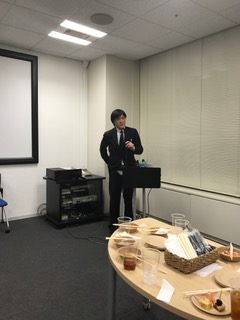
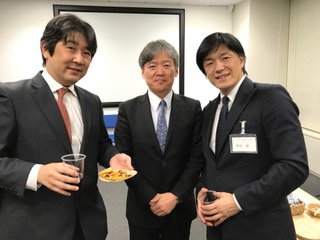
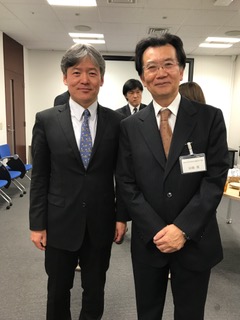
-
The 9th symposium
- Speech
-
-
Special Lecture
“Elucidation of Genomic and Epigenomic Evolution and Diversity in Colorectal Cancer”
Koshi Mimori, Professor of Surgery (Kyushu University Beppu Hospital) -

Both the morbidity and mortality of colorectal cancer in Japan have been increasing, and it is indisputable that intratumor heterogeneity/diversity is one of the major factors responsible. To improve the survival prognosis in patients with colorectal cancer, it is crucial to understand both the genomic and epigenomic evolution events that determine the evolutionary mechanisms of the cancer cells themselves, comprehensively, in chronological order. We performed intratumoral diversity analysis in a single colorectal cancer tumor by the multiple region partitioning analysis method, and elucidated the evolutionary patterns of the spatio-temporal cancer genome and epigenome by leading their lineage trees through mathematical and statistical processing of the “founder genome mutations (main clone)” ubiquitously existing in the whole tumor, and “progressor genome mutations (subclone)” that contribute to the generation of diversity (PLos Genet, 2016). Interestingly, the results revealed that at the genomic level, driver gene mutations were not found in the subclones, and only minor mutations contributed to the generation of diversity. Furthermore, at the epigenomic level, hypermethylation of CpG islands was ubiquitously observed throughout the tumor, while hypomethylation of sea or shore was unevenly distributed, resulting in the formation of diversity. The evolutionary patterns we found were different from those observed in existing cancer evolution models (ex. Big Bang model). We also found that the currently detected cancer evolutionary mechanisms generating intratumor heterogeneity had hardly been known previously. Therefore, to achieve elucidation of the mechanisms, we would like to demonstrate the results of our exhaustive search for conditions that would allow reproduction of such extensive intratumor heterogeneity, as observed in experimental data on colorectal cancer by establishing a cancer divergent evolution model (branching evolutionary process model; BEP model) and performing highly concurrent simulation with the super computer “Kei,” and also explain selective-pressure generating cancer diversity.
-
Research Presentation
“Identification of Cancer Treatment Resistance Genes based on a Comprehensive Gene Search Using Microarray Technologies and Comparative Oncology”
Keishi Yamashita, Junior Associate Professor (Kitasato University Department of Surgery) -

The patterns of expression of tumor suppressor genes or proto-oncogenes can be dynamically changed in tumor tissues, and abnormalities may arise from those in either the genome or the epigenome. We have initiated a research project to identify therapeutic targets focusing on whether control of epigenetic abnormalities can suppress cancer, and how epigenetic abnormalities may be involved in treatment resistance. Phenylbutyrate (PB) has an antagonistic action on histone deacetylation (HDAC), and strongly suppresses cancer cell proliferation through epigenetic mechanisms. The degree of suppression may vary depending on the type of cancer cell; therefore, while considering treatment strategies, it is important to identify the molecular mechanisms responsible for such variations. Exploratory studies on breast and colorectal cancers revealed close involvement the Zeb1 and Ascl2 genes, respectively, in treatment resistance of. In the former, the abnormalities were of epigenetic origin, while in the latter, they were of genetic origin. Anti- significant differences in the resistance and sensitivity to OBP801, which is a more effective HDAC inhibitor than PB, were observed among cell lines of esophagus cancer. Considering this result, we identified SOX2 and delta p63 as candidate genes to explain such differences, and are conducting their functional analyses. Thus, the molecules associated with drug resistance can vary by type of cancer, and both genomic and epigenetic mechanisms may be involved in their expression. Thus, the molecular strategies needed for identification of target molecules aimed at cancer treatment can vary by the type of cancer.
-







